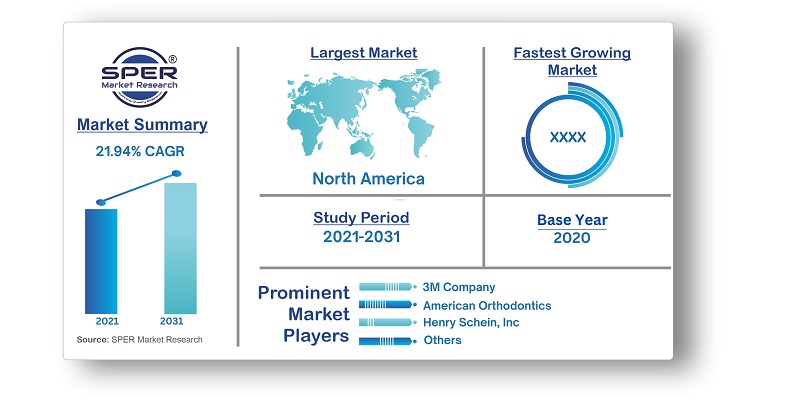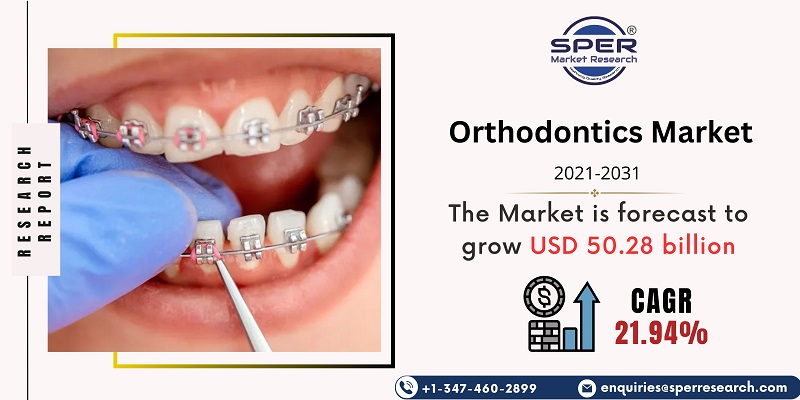
Orthodontics Market Growth, Size, Trends, Demand, Challenges, Competition and Future Outlook
Orthodontics Market Size- By Product Type, By End User - Regional Outlook, Competitive Strategies and Segment Forecast to 2031
| Published: May-2021 | Report ID: HLCA2110 | Pages: 1 - 213 | Formats*: |
| Category : Healthcare | |||
- In February 2023, makeO, an Indian health technology startup, bought Smileneo, which wants to be the leading clinical beauty technology platform in both the Asian and MENA markets.
- Orthobrain joined with OrthoSelect in November 2022 to provide orthodontists with cost-effective clear aligner solutions, resulting in increased productivity and profitability.


| Report Metric | Details |
| Market size available for years | 2019-2031 |
| Base year considered | 2020 |
| Forecast period | 2021-2031 |
| Segments covered | By Product Type, By End User |
| Regions covered | North America, Asia-Pacific, Latin America, Middle East & Africa and Europe. |
| Companies Covered | 3M Company, Align Technology, Inc., American Orthodontics, Dentaurum GmbH & Co. KG, Dentsply Sirona Inc., Envista Holdings Corporation, G&H Orthodontics, Inc., Henry Schein, Inc., Rocky Mountain Orthodontics, Inc. |
- Pharmaceutical and Biotechnology Companies
- Medical Device Manufacturers
- Healthcare Providers and Systems
- Payers and Insurers
- Academic and Research Institutions
- Health Technology Assessment (HTA) Bodies
- Others
| By Product Type: |
|
| By End User: |
|
- Global Orthodontics Market Size (FY’2021-FY’2031)
- Overview of Global Orthodontics Market
- Segmentation of Global Orthodontics Market By Product Type (Instruments, Supplies, Removable)
- Segmentation of Global Orthodontics Market By End User (Dentist Orthodontist Owned Practices)
- Statistical Snap of Global Orthodontics Market
- Expansion Analysis of Global Orthodontics Market
- Problems and Obstacles in Global Orthodontics Market
- Competitive Landscape in the Global Orthodontics Market
- Impact of COVID-19 and Demonetization on Global Orthodontics Market
- Details on Current Investment in Global Orthodontics Market
- Competitive Analysis of Global Orthodontics Market
- Prominent Players in the Global Orthodontics Market
- SWOT Analysis of Global Orthodontics Market
- Global Orthodontics Market Future Outlook and Projections (FY’2021-FY’2031)
- Recommendations from Analyst
1.1. Scope of the report1.2. Market segment analysis
2.1. Research data source2.1.1. Secondary Data2.1.2. Primary Data2.1.3. SPER’s internal database2.1.4. Premium insight from KOL’s2.2. Market size estimation2.2.1. Top-down and Bottom-up approach2.3. Data triangulation
4.1. Driver, Restraint, Opportunity and Challenges analysis4.1.1. Drivers4.1.2. Restraints4.1.3. Opportunities4.1.4. Challenges4.2. COVID-19 Impacts of the Global Orthodontics Market
5.1. SWOT Analysis5.1.1. Strengths5.1.2. Weaknesses5.1.3. Opportunities5.1.4. Threats5.2. PESTEL Analysis5.2.1. Political Landscape5.2.2. Economic Landscape5.2.3. Social Landscape5.2.4. Technological Landscape5.2.5. Environmental Landscape5.2.6. Legal Landscape
5.3. PORTER’s Five Forces
5.3.1. Bargaining power of suppliers5.3.2. Bargaining power of buyers5.3.3. Threat of Substitute5.3.4. Threat of new entrant5.3.5. Competitive rivalry5.4. Heat Map Analysis
6.1. Global Orthodontics Market Manufacturing Base Distribution, Sales Area, Product Type6.2. Mergers & Acquisitions, Partnerships, Product Launch, and Collaboration in Global Orthodontics Market
7.1. Global Orthodontics Market Value Share and Forecast, By Product Type, 2021-20317.2. Instruments7.3. Supplies7.3.1. Fixed7.3.2. Brackets7.3.3. Bands & Buccal Tubes7.3.4. Archwires7.3.5. Others7.3.6. Removable7.3.7. Aligners7.3.8. Retainers7.3.9. Others
8.1. Global Orthodontics Market Value Share and Forecast, By End User, 2021-20318.2. Dentist & Orthodontist Owned Practices8.3. Others
9.1. Global Orthodontics Market Size and Market Share
10.1. Global Orthodontics Market Size and Market Share By Product Type (2019-2026)10.2. Global Orthodontics Market Size and Market Share By Product Type (2027-2031)
11.1. Global Orthodontics Market Size and Market Share By End User (2019-2026)11.2. Global Orthodontics Market Size and Market Share By End User (2027-2031)
12.1. Global Orthodontics Market Size and Market Share By Region (2019-2026)12.2. Global Orthodontics Market Size and Market Share By Region (2027-2031)12.3. Asia-Pacific12.3.1. Australia12.3.2. China12.3.3. India12.3.4. Japan12.3.5. South Korea12.3.6. Rest of Asia-Pacific12.4. Europe12.4.1. France12.4.2. Germany12.4.3. Italy12.4.4. Spain12.4.5. United Kingdom12.4.6. Rest of Europe12.5. Middle East and Africa12.5.1. Kingdom of Saudi Arabia12.5.2. United Arab Emirates12.5.3. Rest of Middle East & Africa12.6. North America12.6.1. Canada12.6.2. Mexico12.6.3. United States12.7. Latin America12.7.1. Argentina12.7.2. Brazil12.7.3. Rest of Latin America
13.1. 3M Company13.1.1. Company details13.1.2. Financial outlook13.1.3. Product summary13.1.4. Recent developments13.2. Align Technology, Inc.13.2.1. Company details13.2.2. Financial outlook13.2.3. Product summary13.2.4. Recent developments13.3. American Orthodontics13.3.1. Company details13.3.2. Financial outlook13.3.3. Product summary13.3.4. Recent developments13.4. Dentaurum GmbH & Co. KG13.4.1. Company details13.4.2. Financial outlook13.4.3. Product summary13.4.4. Recent developments13.5. Dentsply Sirona Inc.13.5.1. Company details13.5.2. Financial outlook13.5.3. Product summary13.5.4. Recent developments13.6. Envista Holdings Corporation13.6.1. Company details13.6.2. Financial outlook13.6.3. Product summary13.6.4. Recent development13.7. G&H Orthodontics, Inc. (Altaris Capital Partners, LLC)13.7.1. Company details13.7.2. Financial outlook13.7.3. Product summary13.7.4. Recent development13.8. Henry Schein, Inc.13.8.1. Company details13.8.2. Financial outlook13.8.3. Product summary13.8.4. Recent development13.9. Rocky Mountain Orthodontics, Inc.13.9.1. Company details13.9.2. Financial outlook13.9.3. Product summary13.9.4. Recent development13.10. Others
SPER Market Research’s methodology uses great emphasis on primary research to ensure that the market intelligence insights are up to date, reliable and accurate. Primary interviews are done with players involved in each phase of a supply chain to analyze the market forecasting. The secondary research method is used to help you fully understand how the future markets and the spending patterns look likes.
The report is based on in-depth qualitative and quantitative analysis of the Product Market. The quantitative analysis involves the application of various projection and sampling techniques. The qualitative analysis involves primary interviews, surveys, and vendor briefings. The data gathered as a result of these processes are validated through experts opinion. Our research methodology entails an ideal mixture of primary and secondary initiatives.



Frequently Asked Questions About This Report
PLACE AN ORDER
Year End Discount
Sample Report
Pre-Purchase Inquiry
NEED CUSTOMIZATION?
Request CustomizationCALL OR EMAIL US
100% Secure Payment






Related Reports
Our Global Clients
Our data-driven insights have influenced the strategy of 200+ reputed companies across the globe.




















